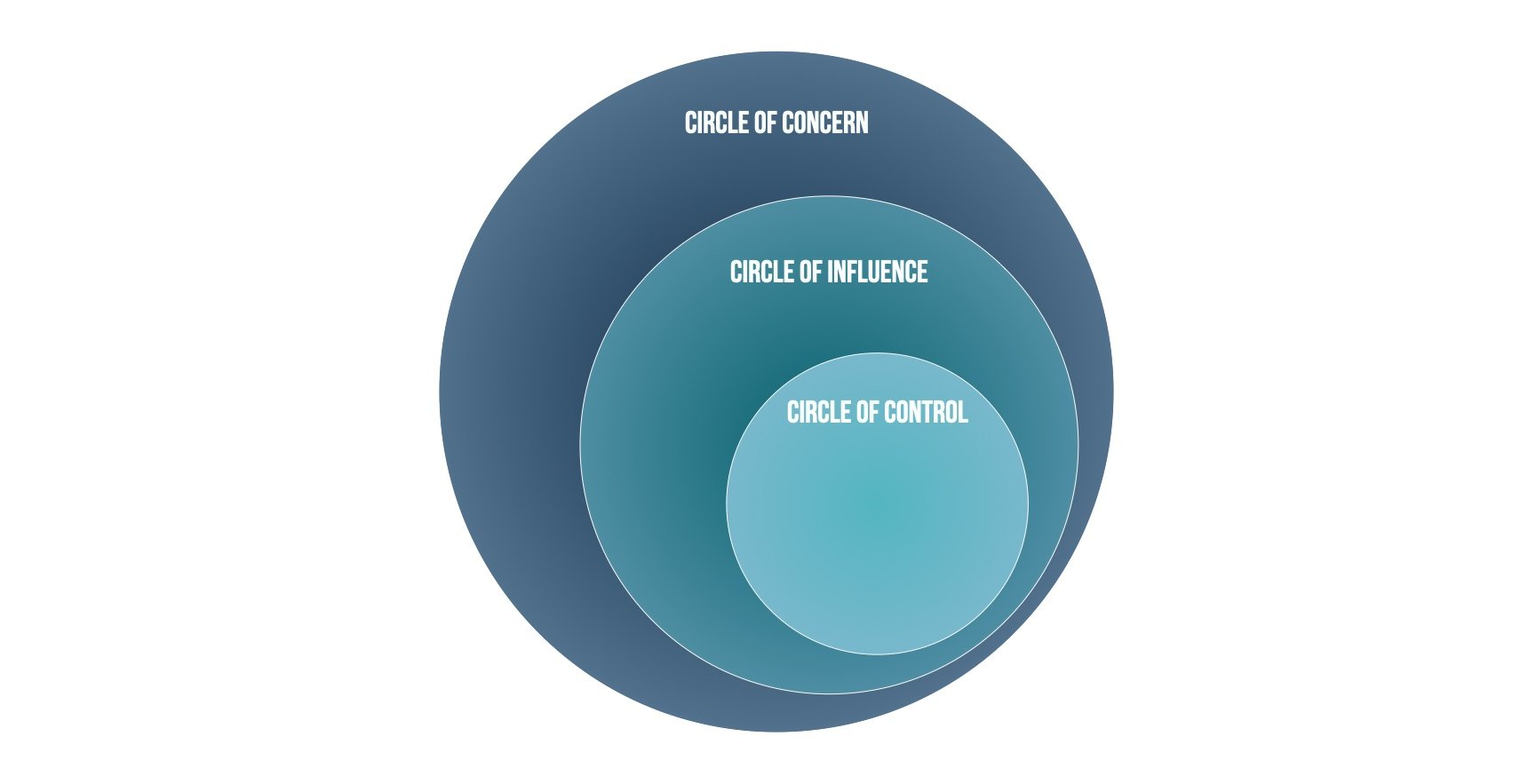A powerful strategy for overwhelmed leaders and managers
If you’re a leader or manager who’s ever felt overwhelmed, you’re not alone. Every day, you’re likely faced with countless decisions, demands, and challenges that can leave your resources stretched too thin. You’re expected to deliver results, motivate your team, navigate office politics, and adapt to changing markets—all while maintaining a semblance of work-life balance. It’s no wonder that stress and burnout are common in leadership roles. But what if we told you that there’s a way to regain control and channel your energy more effectively? That’s where the concept of "circles of control" comes into play.
The Power of Focus
The idea of circles of control comes from the work of Stephen Covey, but it’s a concept that resonates deeply with the teachings of many leadership experts, including myself. At its core, this concept is about focusing your energy where it matters most.
The innermost circle is your Circle of Control, which includes everything you have direct power over—your actions, your decisions, your mindset. The next layer is your Circle of Influence, which consists of things you can affect indirectly, like your team's performance or company culture. The outermost layer is your Circle of Concern, which contains everything you worry about but have no control over—global economic trends, natural disasters, or even other people’s opinions.
Shift Your Focus to Where It Matters
Here’s the problem most leaders and managers face: they spend too much time and energy in the Circle of Concern. They worry about things they can’t control and get frustrated when they can’t change them. This leads to stress, anxiety, and a feeling of helplessness. Sound familiar? But here’s the game-changer: by consciously shifting your focus to your Circle of Control, you reclaim your power and start making a real impact.
Think about it. When you focus on what you can control—your own actions and reactions—you’re empowered. You stop wasting energy on things outside of your influence and start investing it in areas where you can make a difference. For example, instead of worrying about an economic downturn (Circle of Concern), focus on improving your team's skills, streamlining processes, or finding innovative ways to deliver value to your customers (Circle of Control). This shift in focus can transform your leadership and reduce your feelings of overwhelm.
The 3-Step Strategy to Master Your Circles of Control
To harness the power of circles of control, you need a strategy. Here’s a simple yet effective 3-step process:
Identify Your Circles: The first step is to clearly identify what belongs in each of your circles. Take some time to list down everything that’s on your mind. Then, categorize them into the three circles: Control, Influence, and Concern. This exercise alone can be incredibly enlightening. You might be surprised at how much time you’re spending on things outside of your control.
Shift Your Focus and Energy: Now that you’ve identified your circles, it’s time to consciously shift your focus and energy to your Circle of Control. This means prioritising actions and decisions that are within your direct power. If you find yourself drifting into the Circle of Concern, gently remind yourself to refocus. This isn’t about ignoring reality or pretending challenges don’t exist; it’s about choosing where to put your energy for maximum impact.
Expand Your Circle of Influence: While your Circle of Concern is off-limits, your Circle of Influence is a fertile ground for growth. Ask yourself, "How can I influence this situation?" or "Who can I collaborate with to make a change?" By focusing on your Circle of Influence, you can gradually expand your reach and impact. But remember, this expansion is most effective when you’re grounded in your Circle of Control.
The mindset shift for resilient leadership
The magic of circles of control isn’t just about prioritising your actions; it’s about cultivating a resilient mindset. When you operate primarily from your Circle of Control, you develop a sense of ownership and accountability. You start seeing yourself as the driver of your destiny, not a passive victim of circumstances. This mindset shift is crucial for effective leadership. It enables you to navigate uncertainty with confidence, inspire your team through challenges, and stay committed to your vision even when the going gets tough.
Practical Tips to Stay in Your Circle of Control
As you integrate the circles of control into your leadership practice, here are some practical tips to keep you on track:
Set Clear Boundaries: Protect your time and energy by setting boundaries around your Circle of Control. This might mean saying "no" more often or delegating tasks that fall outside your immediate control.
Practice Mindfulness: Regular mindfulness practices, such as meditation or deep breathing, can help you stay centred in your Circle of Control. When you’re mindful, you’re more aware of where your thoughts and energy are going, allowing you to course-correct as needed.
Stay Solution-Oriented: Whenever a problem arises, ask yourself, "What’s within my control here?" Focus on actionable steps rather than dwelling on the problem itself. This keeps you proactive and solution-oriented.
Reclaim Your Power as a Leader
As a leader or manager, you have a tremendous amount of power—but only if you choose to focus on what you can control. The circles of control are a simple yet profound tool to help you reclaim that power. By understanding and applying this concept, you can reduce overwhelm, boost your effectiveness, and lead with greater confidence and clarity. Remember, your power lies not in what happens to you, but in how you choose to respond. So, step into your Circle of Control and start leading from a place of strength and empowerment today.
If you’re looking for ways to develop as a leader or manager, join us at our next Culture Clinic. It’s an opportunity to enhance your leadership coaching and listening skills, as well as to get support with a cultural challenge you're facing. Find out more here.

